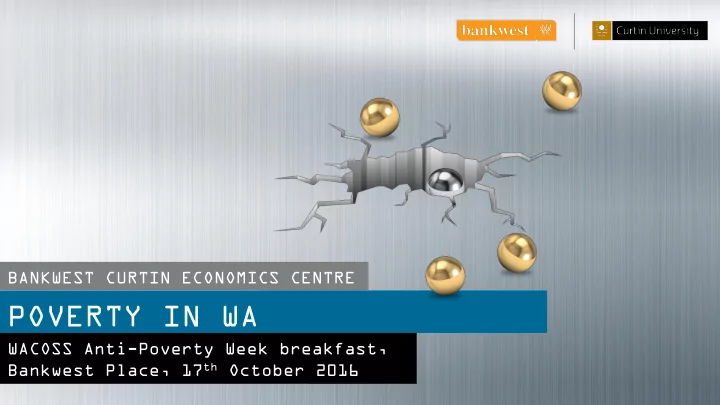

BANKWEST CURTIN ECONOMICS CENTRE POVERTY IN WA WACOSS Anti-Poverty Week breakfast, Bankwest Place, 17 th October 2016
Alan Duncan Director, Bankwest Curtin Economics Centre
Roadmap • How to measure income poverty? • Incidence and depth of income poverty • Issues for Western Australia • Prevalence of poverty – who are at highest risk? • Health consequences of persistent poverty
What is income poverty? • A measure of the deficiency of income relative to a benchmark. • ‘Standard’ income poverty measure is 50% median. • More severe measure – 30% median. • Standardised to control for household needs, using equivalised disposable income after housing costs.
Distribution of equivalised income and poverty lines Equivalised income ($ per week)
Depth of income poverty
Poverty issues for Western Australia • Studies like WACOSS’ Cost of Living survey are essential to provide poverty analysis with a greater WA context. • ‘Typical’ disposable incomes in WA are higher than most other states and territories, BUT • This has an effect on prices and the cost of living, which is demonstrably higher in WA than many other states. • Hence, the real value of income for those on government payments or pensions is lower in WA than elsewhere.
Median incomes differ across states and territories Median equivalised disposable incomes by state/territory and State year ($ per week, 2016 prices) 2005-06 2007-08 2009-10 2011-12 2013-14 2003-04 New South Wales 553 569 627 656 670 691 4 Victoria 551 573 682 664 661 712 3 Queensland 508 576 668 654 670 671 5 South Australia 508 543 625 654 627 639 6 Western Australia 534 590 707 708 760 775 2 Tasmania 495 526 567 594 604 628 7 ACT/NT 681 767 852 917 899 940 1 Australia 537 574 656 666 678 697
State median incomes as a share of national median Median equivalised disposable incomes by state/territory and State year as a share of national median (%) 2005-06 2007-08 2009-10 2011-12 2013-14 2003-04 New South Wales 103% 99% 96% 98% 99% 99% Victoria 103% 100% 104% 100% 97% 102% Queensland 95% 100% 102% 98% 99% 96% South Australia 95% 95% 95% 98% 92% 92% Western Australia 99% 103% 108% 106% 112% 111% Tasmania 92% 92% 86% 89% 89% 90% ACT/NT 127% 134% 130% 138% 133% 135%
Poverty rates using state-specific median incomes National State Median equivalised disposable incomes by state/territory and poverty poverty State year as a share of national median (%) line line 2003-04 2005-06 2007-08 2009-10 2011-12 2013-14 New South Wales 103% 99% 96% 98% 99% 99% 16.6% 16.6% Victoria 103% 100% 104% 100% 97% 102% 16.6% 15.9% Queensland 95% 100% 102% 98% 99% 96% 16.0% 14.6% South Australia 95% 95% 95% 98% 92% 92% 14.9% 12.2% Western Australia 99% 103% 108% 106% 112% 111% 14.1% 17.6% Tasmania 92% 92% 86% 89% 89% 90% 16.7% 11.9% ACT/NT 127% 134% 130% 138% 133% 135% 10.2% 15.8%
WA poverty rates by tenure and family Proportion of households with equivalised disposable incomes below 50% of median , by family and housing status Mortgage Owner, no Household type mortgage holder Renter Non-elderly couple only 8.4% 6.2% 7.2% Non-elderly couple with kids 2.8% 6.0% 17.0% One parent with kids 3.1% 22.9% 30.0% Non-elderly single male 7.5% 16.8% 15.9% Non-elderly single female 13.1% 20.7% 27.5% Elderly couple 3.6% 7.6% 19.7% Elderly single male 2.0% 9.3% 39.6% Elderly single female 5.9% 12.1% 30.1%
WA poverty count by tenure and family Number of people with equivalised disposable incomes below 50% of median, by family Mortgage Owner, no Household type holder Renter mortgage Non-elderly couple only 8,058 13,383 9,946 Non-elderly couple with kids 5,510 52,085 53,294 One parent with kids 618 8,930 30,985 Non-elderly single male 1,099 5,314 7,632 Non-elderly single female 2,037 4,482 6,899 Elderly couple 7,379 1,611 3,378 Elderly single male 385 21 3,616 Elderly single female 2,725 221 2,956 27,811 86,047 118,706
Who faces a higher incidence of income poverty? • Single parent and lone person households • Renting • Low qualifications • Household head is female and relatively young • Indigenous families • Those with long-term health issue or disability
Being single • Single (with or without children) increases risk of poverty • More likely to be experiencing financial hardship and material deprivation. • Over 25% of persons in single parent households are in poverty and one in seven in severe poverty. • Lone person - $145; single parent - $280 per week
Being single
Being single - persistence • Singles are far more likely to be in poverty for longer • One-third of a million (337,000) lone persons have been in poverty for at least five of the last ten years. • A quarter of a million (235,000) single parents have been in poverty for at least five of the last ten years. • One in four elderly single male or female households have been in poverty for four or more years.
Housing • Poverty rate for renters in Australia more than twice that for mortgage holders and three times the rate for owners without mortgages. • Huge increase in poverty across the life-course for single people in rented accommodation. • Around 29% of lone renters aged under 35 are in poverty, but the rate rises to nearly 40% for lone persons aged 35 to 54 and more than half for those approaching retirement age.
Employment • Strong relationship between joblessness and poverty • Jobless households are over-represented at various poverty depths, and are 7 times more likely to be in severe poverty than other households • Severe poverty rises significantly with the duration of unemployment
Employment • But – journey to employment and employment as a means of escaping poverty isn’t straightforward. • Working poor • Locational Disadvantage • Indigenous • Disability
Persistent poverty increases psychological distress…
Who is falling through the cracks? • Housing • Jobless households • Being single • Health and Disability • Indigenous • Location
Recommend
More recommend